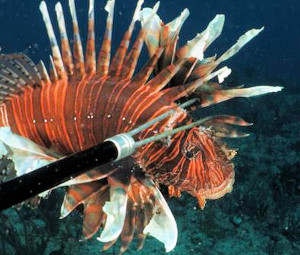What do you do with an invasive fish, covered from head to fin with venomous spines as sharp as hypodermic needles; a fish that can’t be caught with a rod or in a trawling net as it multiplies rapidly, deep in our oceans, flummoxing fishermen and scientists alike? Lionfish.
Note: Venomous is not the same as Poisonous. Venomous describes an animal that injects venom into a victim through a bite or sting. Poisonous describes a plant, animal or other substance that causes sickness or death if inhaled, ingested or touched.
Conservationists are hoping you eat it.
The Indo-Pacific native lionfish arrived in the Atlantic about a decade ago, the product of well-meaning aquarium owners who released their charges into the ocean, not realizing they reproduce at an alarming rate, prey on more than 70 species of fish and hasten the dying-off of any coral reef they alight on. Scientists describe their invasion into Florida’s waters in the same words noted Key West fisherman Ernest Hemingway used to describe the onset of bankruptcy: slowly, and then all at once. Now estimated to number as many as 1,000 fish per acre, lionfish also have no known predators — except humans.

Click on Photo for Larger View
“They grow very quickly, so they can reach sexual maturity in less than a year. They eat a tremendous amount, and our native marine life don’t see them as a threat,” said Lad Akins, a lionfish expert who recently retired from his job as director of special projects at the conservationist organization REEF.
Read more at the link below.
Source: The invasive, venomous lionfish is killing Atlantic reefs. So please eat it. – VICE News
